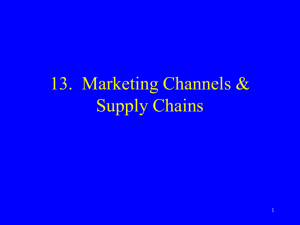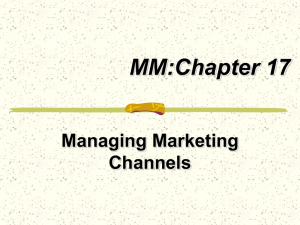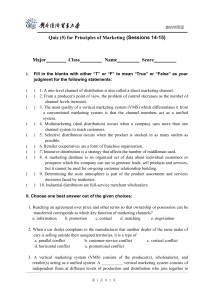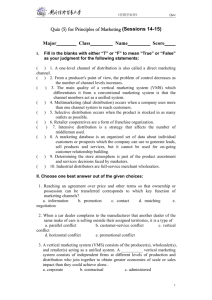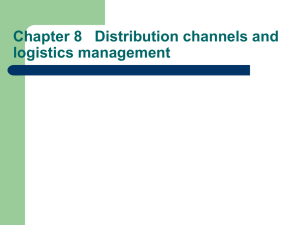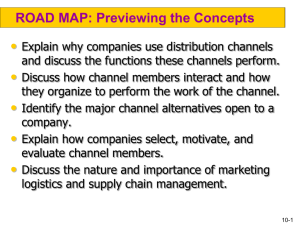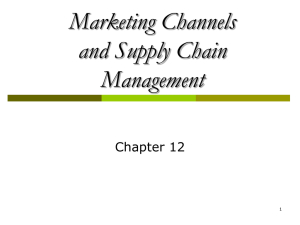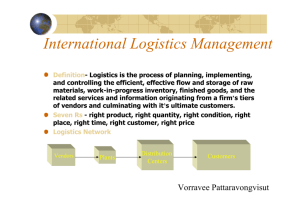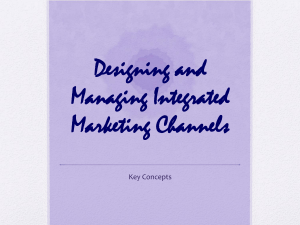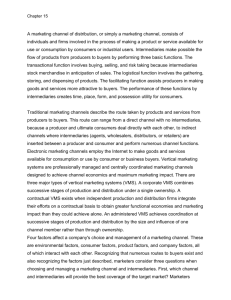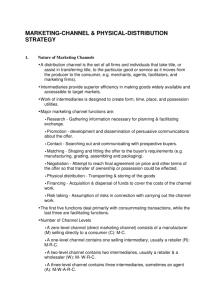Chapter 11 - Sharif MBA Students Forum
advertisement
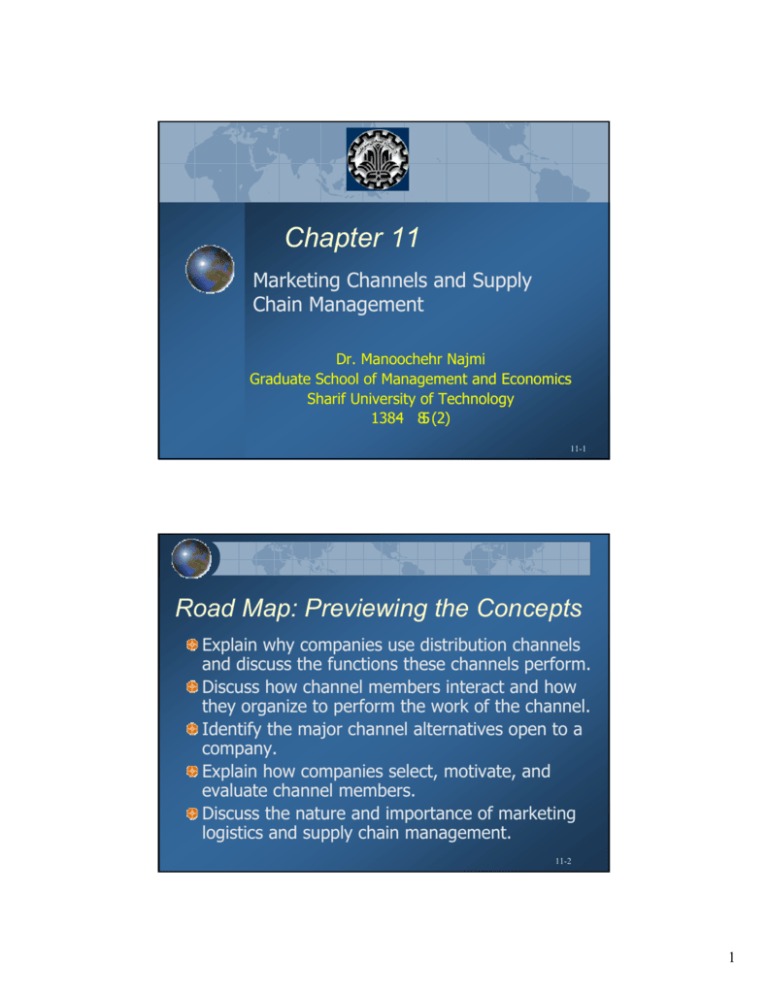
Chapter 11 Marketing Channels and Supply Chain Management Dr. Manoochehr Najmi Graduate School of Management and Economics Sharif University of Technology 1384 - 85 (2) 11-1 Road Map: Previewing the Concepts Explain why companies use distribution channels and discuss the functions these channels perform. Discuss how channel members interact and how they organize to perform the work of the channel. Identify the major channel alternatives open to a company. Explain how companies select, motivate, and evaluate channel members. Discuss the nature and importance of marketing logistics and supply chain management. 11-2 1 What is a Distribution Channel? Set Set of of interdependent interdependent organizations organizations involved involved in in the the process process of of making making aa product product or or service service available available for for use use or or consumption consumption by by the the consumer consumer or or business business user. user. 11-3 Why are Marketing Intermediaries Used? The use of intermediaries results from their greater efficiency in making goods available to target markets. Offers the firm more than it can achieve on its own through the intermediaries: Contacts, Experience, Specialization, Scale of operation. Purpose: match supply from producers to demand from consumers. 11-4 2 A Distributor Reduces the Number of Channel Transactions (Fig. 11-1) 11-5 Distribution Channel Functions These Functions Should be Assigned to the Channel Member Who Can Perform Them Most Efficiently and Effectively. Risk Risk Taking Taking Information Information Financing Financing Promotion Promotion Physical Physical Distribution Distribution Contact Contact Negotiation Negotiation Matching Matching 11-6 3 Number of Channel Levels (Fig. 11-2) 11-7 Channel Behavior & Organization The channel will be most effective when: each member is assigned tasks it can do best. all members cooperate to attain overall channel goals and satisfy the target market. When this doesn’t happen, conflict occurs: Horizontal Conflict occurs among firms at the same level of the channel, i.e retailer to retailer. Vertical Conflict occurs between different levels of the same channel, i.e. wholesaler to retailer. Each channel member’s role must be specified and conflict must be managed. 11-8 4 Conventional Distribution Channel Vs. a Vertical Marketing System (Fig. 11-3) 11-9 Types of Vertical Marketing Systems Corporate VMS Common Ownership at Different Levels of the Channel i.e. Sears Degree of Direct Control Contractual VMS Contractual Agreements Among Channel Members i.e Western Auto Administered VMS Leadership is Assumed by One or a Few Dominant Members i.e. Kraft 11-10 5 Types of Vertical Marketing Systems Vertical Vertical Marketing Marketing Systems Systems (VMS) (VMS) Corporate Corporate VMS VMS Wholesaler Wholesaler Sponsored Sponsored Voluntary Voluntary Chain Chain ManufacturerManufacturerSponsored Sponsored Retailer Retailer Franchise FranchiseSystem System Contractual Contractual VMS VMS Retailer Retailer Cooperatives Cooperatives Administered Administered VMS VMS Franchise Franchise Organizations Organizations ManufacturerManufacturerSponsored Sponsored Wholesaler Wholesaler Franchise FranchiseSystem System Service-FirmService-FirmSponsored Sponsored Retailer Retailer Franchise FranchiseSystem System 11-11 Innovations in Marketing Systems Horizontal Horizontal Marketing Marketing System System Two Two or or More More Companies Companies at One at One Channel Channel Level Level Join Join Together Together to to Follow a New Follow a New Marketing Marketing Opportunity. Opportunity. Example: Example: Banks Banks in in Grocery Grocery Stores Stores Hybrid Marketing Marketing Hybrid System System Single Firm Firm Sets Sets Up Up AA Single Two or or More More Marketing Marketing Two Channels to Reach Channels to Reach One or More Customer One or More Customer Segments. Segments. Example: Example: Retailers, Catalogs, Catalogs, Retailers, and Sales Sales Force Force and 11-12 6 Toys “R” Us Partner Western Publishing Group partners with Toys “R” Us to create mini-bookstore sections – called Books “R” Us – within each store. This helps to build channel partnerships that benefit both companies. 11-13 Hybrid Marketing Channel (Fig. 11-4) 11-14 7 Changing Channel Organization A Major Trend is Toward Disintermediation Which Means that Product and Service Producers are Bypassing Intermediaries and Going Directly to Final Buyers or That New Types of Channel Intermediaries are Emerging to Displace Traditional Ones. 11-15 Channel Design Decisions Analyzing Consumer Service Needs Setting Channel Objectives & Constraints Identifying Major Alternatives Types of Intermediaries Number of Intermediaries Responsibilities of Intermediaries Evaluating the Major Alternatives Designing International Distribution Channels 11-16 8 Number of Marketing Intermediaries Intensive Intensive Distribution Distribution Selective Selective Distribution Distribution Exclusive Exclusive Distribution Distribution 11-17 Channel Management Decisions Motivating Motivating Channel Channel Members Members FEEDBACK Selecting Selecting Channel Channel Members Members Evaluating Evaluating Channel Channel Members Members 11-18 9 Marketing Logistics and Supply Chain Management Involves getting the right product to the right customers in the right place at the right time. Marketing logistics addresses: Outbound distribution, Inbound distribution, Reverse distribution, Entire supply chain management. 11-19 Supply Chain Management (Fig. 11-5) 11-20 10 Goals of the Logistics System Higher Distribution Costs; Higher Customer Service Levels Goal: To Provide a Targeted Level of Customer Service at the Least Cost. Lower Distribution Costs; Lower Customer Service Levels 11-21 Major Logistics Functions Order Order Processing Processing Received Received Processed Processed Shipped Shipped Costs Costs Minimize Minimize Costs Costs of of Attaining Logistics Attaining Logistics Objectives Objectives Logistics Transportation Rail, Truck, Water, Pipeline, Air, Intermodal Functions Inventory Inventory When When to to order order How How much much to to order order Just in time Just- in - time Warehousing Warehousing Storage Storage Distribution Distribution Automated Automated 11-22 11 Transportation Modes Rail Rail Nation’s Nation’s largest largest carrier, carrier, cost-effective cost-effective for shipping for shipping bulk bulk products products Truck Truck Flexible Flexible in in routing routing && time time schedules, schedules, efficient efficient for short-hauls of high for short-hauls of high value value goods goods Water Water Low Low cost cost for for shipping shipping bulky, bulky, low-value, low-value, non-perishable goods, non-perishable goods, slowest slowest form form Pipeline Pipeline Ship Ship petroleum, petroleum, natural natural gas, gas, and and chemicals chemicals from sources to markets from sources to markets Air Air High High cost, cost, ideal ideal when when speed speed isis needed needed or or distance markets have to be reached distance markets have to be reached 11-23 Integrated Logistics Management Concept Recognizes that Providing Better Customer Service and Trimming Distribution Costs Requires Teamwork, Both Inside the Company and Among All the Marketing Channel Organizations. Involves: Cross- functional teamwork inside the company Building channel partnerships Third - party logistics 11-24 12
